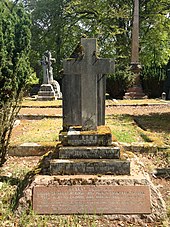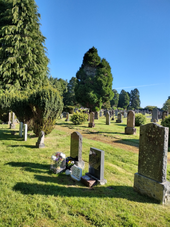| Tomnahurich Cemetery Hill | |
|---|---|
 SW view of the hill SW view of the hill | |
| Details | |
| Established | 1864 |
| Location | Inverness |
| Country | Scotland |
| Coordinates | 57°28′01″N 4°14′34″W / 57.46687°N 4.242654°W / 57.46687; -4.242654 |
| Type | Public |
The Tomnahurich Cemetery is a Victorian cemetery in Inverness, Scotland.
Etymology
Tomnahurich is a Scottish Gaelic place-name which means "hill of the yew wood", tom na h-iubhraich, as was pointed out by Professor W. J. Watson in his magisterial and ground-breaking work of 1926, The Celtic Place-Names of Scotland. Watson himself is actually buried in the cemetery here, under a fine monument. The name does not mean 'hill of the fairies', as has been suggested. There is, however, a local Gaelic story Aonghas Mòr Thom na h-Iubhraich agus na Sìthichean ("Big Angus of Tomnahurich and the Fairies"), so there is a folk story about fairies associated with the hill.
Features
The cemetery is located on a low but very prominent hill 1.5 km SW of the city centre, between the Caledonian Canal and the River Ness. The hilltop is at 70 m, and its topographic prominence is 53 m. The cemetery consists in two areas: a formal graveyard on the upper plateau, which also hosts a war memorial, and the Lower Cemetery, occupying the low ground around the hill. Some footpaths connect these two burial areas. The hillside is covered in woodland and provides a convenient habitat to several bird species. The hilltop offers a wide panorama on Inverness city, the Moray Firth and on the Ness Valley. The Tomahurich itself, as seen from the surrounding plain, is an important landmark.
History

Before its use as a cemetery the hill, due to its prominent location, hosted various social events such as an annual horse race, which used to take place around the hill on the 24–25th May. In 1753 the hill, which ground was considered too poor in quality for agriculture, was planted with trees, mainly Pinus sylvestris. The views offered from the hilltop were praised by artists and scientists. For instance Thomas Pennant climbed the Tomnahurich in the 18th Century, reporting its name as Tommin heurich. In the second half of the 19th century the Inverness Cemetery Company, a joint-stock company, developed the present-day cemetery and opened it in 1864. Although its design is attributed to Charles Heath Wilson, a great deal of the work was done by George Grant Mackay, a Scottish civil engineer. The cemetery gradually expanded also around the hill, and in 1909 it was acquired by the Borough of Inverness. During the Second World War lots of metallic chains and iron parts were removed from the cemetery, to contribute in the national war effort.
Artworks

Many tombstones and structures of the cemetery are of historic and architectural interest. Among them can be remembered the memorial monument to Mary Anne Lyall, of Andrew Davidson's (1841–1925), or the mausoleum of Henry Christie, with an armed angel statue guarding its marble door. Close to the main entrance stands a lodge designed by Alexander Ross in 1877.
See also
References
![]() Media related to Tomnahurich Cemetery at Wikimedia Commons
Media related to Tomnahurich Cemetery at Wikimedia Commons
- "Tomnahurich". Retrieved 17 June 2022.
- ^ Historic Environment Scotland. "Tomanhurich Cemenetry (Garden and Designated Landscape) (GDL00374)". Retrieved 17 June 2022.
- Pennant, Thomas (1772). A Tour in Scotland. 1769. Vol. 2. B. White at Horace's Head. p. 147. Retrieved 17 June 2022.
- Gifford, John (2003). "Inverness". Highland and Islands. Yale University Press. p. 192. ISBN 9780300096255. Retrieved 17 June 2022.
External links
| Cemeteries in Scotland | |||
|---|---|---|---|
| Argyll and Bute | |||
| Dundee | |||
| East Dunbartonshire | |||
| East Renfrewshire | |||
| Edinburgh | |||
| Falkirk | |||
| Glasgow | |||
| Highland | |||
| Midlothian | |||
| Perth and Kinross | |||